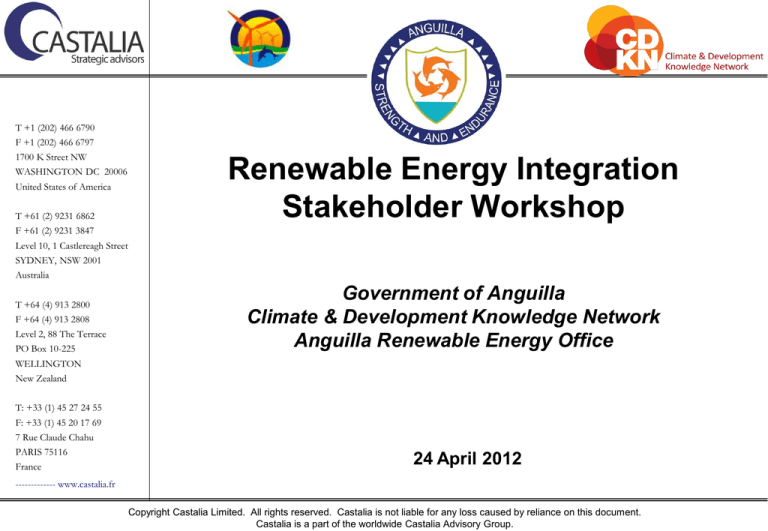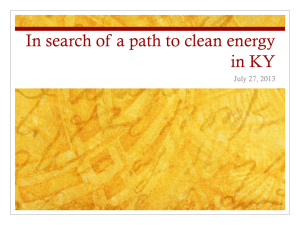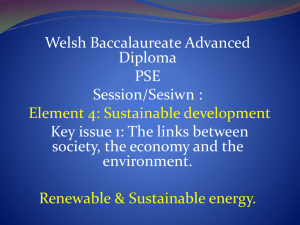
T +1 (202) 466 6790
F +1 (202) 466 6797
1700 K Street NW
WASHINGTON DC 20006
United States of America
T +61 (2) 9231 6862
Renewable Energy Integration
Stakeholder Workshop
F +61 (2) 9231 3847
Level 10, 1 Castlereagh Street
SYDNEY, NSW 2001
Australia
T +64 (4) 913 2800
F +64 (4) 913 2808
Level 2, 88 The Terrace
PO Box 10-225
Government of Anguilla
Climate & Development Knowledge Network
Anguilla Renewable Energy Office
WELLINGTON
New Zealand
T: +33 (1) 45 27 24 55
F: +33 (1) 45 20 17 69
7 Rue Claude Chahu
PARIS 75116
France
24 April 2012
------------- www.castalia.fr
Copyright Castalia Limited. All rights reserved. Castalia is not liable for any loss caused by reliance on this document.
Castalia is a part of the worldwide Castalia Advisory Group.
Agenda
Objectives
Work Plan and Deliverables
Power Sector Overview
Potential for Renewable Energy
Barriers
Recommendations for Renewable Energy Integration
Coffee Break
Break-out Sessions
Lunch
Wrap-Up
1
Objectives
The Government and the Climate & Development Knowledge Network (CDKN)
hired Castalia to recommend how to improve Anguilla’s legal and regulatory
framework to enable integration of renewable energy
Why integrate more RE?
1. To reduce electricity costs—priority objective for Government and
overwhelming majority of stakeholders met
2. To increase energy security—this can be done while reducing costs
since Anguilla’s RE is all win-win
3. To enhance environmental sustainability—this too can be done while
reducing costs since Anguilla’s RE is all win-win
- Local environment (less pollution)
- Global environment (less CO2)
- Increase Resilience to Climate Change and Extreme Events
2
Work Plan and Deliverables
February
Inception
Report
Inception
(1st trip)
March
Assess
Anguilla’s
RE Potential
Identify
Barriers to
RE Potential
Understand facts,
objectives and
concerns
Collect available
information
April
Recommend
Improvements
to Legal and
Regulatory
Framework
Draft
Report 1
Consult remotely
with stakeholders
during the analysis
and the
development of
recommendations
3
May
Draft
Report 2
Stakeholder
Workshop
(2nd trip)
Time for
client and
stakeholder
comments
and peer
review
August
Final
Report/
Explanatory
Note
Final
Presentation
(3rd trip)
Includes
stakeholder
comments
Power Sector Overview—Anguilla’s Fuel Surcharge
4.5
4
3.5
0.40
U.S. Gulf Coast
No. 2 Diesel
(US$/gallon)
0.35
0.30
3
2.5
0.20
2
0.15
1.5
Anguilla Fuel
Charge
(US$/kWh)
1
0.10
0.05
0.5
0
-
4
US$/kWh
US$/gallon
0.25
Power Sector Overview—Generation Costs and Tariffs with US$4 / IG Diesel
Estimated Generation Costs with Diesel at US$4.00/IG (US$ per kWh)
0.35
0.33
0.30
0.27
US$/kWh
0.25
0.20
0.27
0.23
0.15
0.10
0.05
0.06
0.02
-
Capital Costs
High Speed Units
Fixed O&M Costs
Variable O&M Costs
Medium Speed Units
Fuel costs
Major maintenance
Estimated Tariffs with Diesel at US$4 per IG (US$ per kWh)
1-40 kWh /month
41-2,500 kWh /month
2,501 - 100,000 kWh /month
> 100,000 kWh / month
Base Rate (a)
0.21
0.24
0.23
0.16
Fuel surcharge (b)
0.26
0.26
0.26
0.26
5
Total (a+b)
0.47
0.50
0.50
0.42
Potential for Renewable Energy—Good Options, Currently Unrealized
Econ. viable
Comm. viable
Landfill gas to energy (270kW internal
combustion)
0.08
Avg. system variable cost (non-firm, utility): US$0.25/kWh
Solar Water Heater (70kW flat plate,
commercial)
0.09
All-in cost of Wartsilas (firm, utility): US$0.27/kWh
Wind (850kW 'Class 1' turbines)
Avg. system variable cost + losses (non-firm, distributed):
US$0.28/kWh
0.09
Waste to Energy (Anaerobic Digester 100kW)
0.10
Solar Water Heater (2kW flat plate, small)
Tariff 2
(w/o Env. Levy):
US$0.47/kWh
0.13
Wind (275kW lowerable or tiltable turbines)
0.16
Solar PV (2MW monocrystalline, fixed, utility
scale)
Tariff 2 & 3
(w/o Env. Levy):
US$0.50/kWh
0.22
Solar PV (60kW Polycrystalline, fixed,
commercial)
0.24
Solar PV (2kW thin film, fixed, small)
0.28
Wind (10kW distributed scale turbines)
0.35
Solar PV (2kW thin-film, fixed, small, with
battery)
0.45
-
0.10
0.20
US$/kWh 0.30
0.40
0.50
0.60
Note: Indicative Long Run Marginal Costs (LRMCs) of renewable energy technologies (US$/kWh) based on a 11% discount rate for utility
scale technologies, and 9% for distributed scale technologies. Generation costs and tariffs are based on Diesel prices of US$4.00/gallon.
Average system variable cost benchmark for distributed generation technologies are grossed up for losses (12%)
6
Potential for Renewable Energy—Good Options Save CO2 and Money
Solar Water Heater (70kW flat plate, commercial)
Landfill gas to energy (270kW internal combustion)
Waste to Energy (Anaerobic Digester 100kW)
Wind (850kW 'Class 1' turbines)
(287)
CER Price:
US$9.5/tCO2
(279)
(248)
(239)
Solar Water Heater (2kW flat plate, small)
(218)
Wind (275kW lowerable or tiltable turbines)
(134)
Solar PV (60kW Polycrystalline, fixed, commercial)
(62)
Solar PV (2MW monocrystalline, fixed, utility scale)
(43)
Solar PV (2kW thin film, fixed, small)
(9)
Wind (10kW distributed scale turbines)
99
Solar PV (2kW thin-film, fixed, small, with battery)
-400.00
241
-300.00
-200.00
-100.00
Note: CER = Certified Emission Reduction. Price for Carbon from Carbonex on April 15, 2012
7
0.00
100.00
200.00
300.00
Barriers—Is Anything Needed Missing for Viable Renewables to Happen?
Commercial viability of a renewable energy project
-
Utility scale—a project generates at a competitive cost
Distributed scale—a project generates at a cost that saves on one’s bill
Three basic rights any developer of a renewable project needs:
-
Right to use the primary renewable energy resource (sun, wind, waste…)
Right to access and develop the site where to set up and run the project
Right to sell the electricity generated
A good regulatory framework to do renewables in the right way
-
Body of rules that ensure good quality of service at reasonable price
Someone with the power and ability to effectively administer those rules
Other things: skills, information, awareness, financing, good equipment
competitively priced
8
Right to Use the Renewable Energy Resource—No Barriers, No Measure
Right to use solar energy
-
Anyone who can capture it can use it
Anyone can use it to generate electricity
Right to use wind energy
-
Anyone who can capture it can use it
Anyone can use it to generate electricity
Right to use waste
-
Anyone who owns it can use it
Only a public supplier can use it to generate
electricity, but waste is so little in Anguilla that if
anything makes sense, it will be a very small plant
that uses any waste available
9
No barriers—no
measures
needed
Right to Access and Develop the Site—A Barrier for Solar Water Heaters
Access and develop a site for utility scale RE:
-
All rights in place
Difficulties in enforcing them
New procedures in draft legislation may improve the
current situation:
o streamlining the process
o guiding the authorities’ broad discretion
No barriers—no
measures
needed
Access and develop a site for distributed scale RE:
-
All rights in place
-
Problem for solar water heaters—new buildings can
go up in a way that makes it impossible or very
costly to install one
Now:
Distributed scale projects do not qualify as
‘developments’
10
Mandate
Caribbeanappropriate solar
water heaters for
new buildings
Right to Sell Electricity—For Utility Scale Renewables, Good Situation
Three options possible under the current framework
for utility scale
1. ANGLEC can sell electricity generated by renewables
it does itself
2. Independent Power Producers (IPPs) can operate
under ANGLEC’s licence without a new licence by
assignment of rights
3. ANGLEC can hire a specialized contractor to design,
build, operate, and maintain (‘DBOM’)
Only option not possible: IPP with own licence
-
Unnecessary
Now:
Ensure
ANGLEC does
renewables in
the best way
under one of
these options
Later:
Consider
autonomous
licensing
regime for
IPPs… but
don’t do it
Costly and time consuming
Difficult to administer
11
Ensure ANGLEC Does Renewables Well—with Corporate Rules (By-Laws)
ANGLEC’s by-laws regulate how the company is run
-
Includes how business and affairs of the company should be managed
But does not include specific rules—can add specific rules for renewables
Companies Act (s.63) provides the power and procedure to amend bylaws to include specific rules
Now: add Schedule ‘Corporate Rules
for Renewable Energy’
Now: add in by-laws 4.1:
Preamble
“In managing the business and affairs of
the company, the directors, and any
person to whom their powers are
delegated under paragraph 4.10 or
otherwise, shall comply with the
Corporate Rules for Renewable Energy
set out in the Schedule.”
Principles (good quality of service at least
cost, energy security, environmental
sustainability, transparency &
competitiveness in procurement)
Rules for Utility Scale Renewables
Rules for Distributed Scale Renewables
12
ANGLEC’s Corporate Rules for Renewable Energy—Utility Scale
Do demand forecast
Do least cost generation plan with full consideration of RE
Participate in consultation with the public
Approve least cost generation plan
Identify best option to design, build, operate, maintain, finance
1. Fully developed by ANGLEC
2. Procure DBOM contractor
3. Contract IPP
When doing DBOM and IPP: run competitive, transparent
procurement process
-
Clear eligibility criteria, and evaluation process & rules
Prequalification (Expressions of Interest) Request for Proposals
Now:
Request EOIs for
large Solar PV
Now:
Add O&M in RFP
for large PV
Implement / award
13
Right to Sell Electricity—What to Do for Distributed Scale Renewables
Customers cannot connect to the grid and sell excess electricity they
generate with renewable energy
Now: amend Electricity Act Part 2, section 2(2) by adding that one does not need a
licence for use of an electrical plant that…
(a) is powered only by wind and which is used by any person for the purpose only of
supplying electricity to his own premises, or selling excess electricity to a public
supplier on terms agreed with the public supplier;
(b) is used only for the photovoltaic generation of electricity by any person for the purpose
only of supplying electricity to his own premises, or selling excess electricity to a public
supplier on terms agreed with the public supplier.
Now: adopt ANGLEC Corporate Rules on Distributed Renewable Energy
1. Identify technically/economically viable cap for eligible systems
2. Create grid and distributed generation code
3. Create Standard Offer Contract (SOC) with fair and predictable terms
4. Try to secure under public supplier’s licence any change to tariffs and conditions of
supply needed to promote distributed renewables as much as possible
14
ANGLEC’s Corporate Rules for Renewable Energy—Distributed Scale
A standardized ‘package’ of items that must
go together:
1. Cap on individual and total eligibility—
needed for quality, stability, reliability of service
2. Grid code / interconnection agreement—
know in advance what to do to comply
3. Standard Offer Contract (SOC)
- Rate: actual avoided cost under realistic
dispatch conditions—fair value for country
- Term: system lifetime—no uncertainty!
4. Tariff change—to pay separately for:
- Supply of energy
- Backup and standby
- Connection to distribution grid
15
Now:
Issue pilot SOC with limited cap
Now:
Offer pilot disaggregated tariff
under 4(1) of ANGLEC licence /
Electricity Supply Regulations
Having a Good Regulatory Framework in Place—Must Correct Distortions
Anguilla’s regulatory framework is rudimentary and outdated
-
Limited rules on how to plan, implement, operate, and recover investments
Limited regulatory activity and tradition
Designed for an era when renewables were not even an option—only Diesel
Much of this is a problem of power sector reform, beyond just renewables
But this creates barriers to renewables too
-
Investments in diesel generation are safe
thanks to fuel surcharge, but those in
renewables are risky—uncertain recovery
Later:
Ensure good investments in
renewables can be recovered
via tariffs—on a par with Diesel!
-
Rate reviews are rare—and unclear as to
how to do them, and what outcome may be
-
Tariffs bundle all services together (energy,
capacity, connection)
Later: disaggregate tariff
structure for everybody
No regulatory capability anyway
Later: assign regulatory
responsibilities
-
16
Correcting Electricity Regulatory Distortions—Later (but not too late)
Later: commission Cost of Service Study
Later: amend ANGLEC licence and
Electricity Supply Regulations with rate
setting principle for cost recovery
How much it costs to provide different
services to different customers
Define ‘Approved Renewable Energy Costs’
as those incurred in accordance with the
best practice Corporate Rules
Later: amend Electricity (Rates and
Charges) Regulations with a
disaggregated tariff structure
State that ‘Approved Renewable Energy
Costs’ shall be considered reasonable
can be recovered through tariffs
1. Supply of energy
2. Backup and standby
“The Minister or the Arbitrator shall consider
that Approved Renewable Energy Costs are
reasonably incurred”
Later: issue revised SOC
With higher cap, based on pilot experience
3. Connection to distribution grid
Fuel should all be in one fuel surcharge
component, to be published monthly
Can add a Renewable Energy Recovery
Clause for all Approved RE Costs
Later: determine who will administer all these rules—PUC, ECERA, Commissioner?
17
Recommendations for Overcoming Other Barriers
Utility scale RE
Limited institutional
capabilities
Secure funding for further
activities
Distributed scale RE
Secure funding for further
activities
ANGLEC to develop skills to
inspect systems for SOC
Limited skills for
renewables
Include O&M components
when procuring (DBOM),
even brief
Check wireman’s licence
Limited information and
awareness
Assess quantity and quality
of wind and waste
Consider adopting external
certifications for installers
Limited financing
No barrier—no measure
Limited availability of
competitively priced
equipment
No barrier—no measure
Use this report to secure
low-cost financing for solar
PV and solar water heaters
(from UK Government,
ANGLEC if can recover cost)
Check plumber’s licence
Set up consumer finance
initiative
18
Break-Out Sessions
Group 1: Assessing the Potential and Viability of Renewable Energy
Projects
Group 2: Land Use, the Environment, and Development of Renewable
Energy Projects
Group 3: Selling Electricity Generated by Renewable Energy
Technologies
19
Wrap Up
Question or comment
Stakeholder
20
Reply
Contact Information
Gianmarco Servetti
-
Gianmarco.Servetti@castalia-advisors.com
Laura Berman
-
Laura.Berman@castalia-advisors.com
Barbara Vargas
-
barbara_pierre@yahoo.com
21







